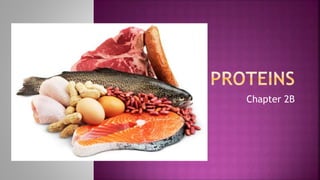
AS Biology - Proteins
- 1. Chapter 2B
- 2. Know the basic structure of an amino acid Understand the formation of polypeptides and proteins, as amino acid monomers linked together by condensation reactions to form peptide bonds Understand the significance of a protein’s primary structure in determining its secondary structure, three- dimensional structure and properties, and the types of bond involved in its three-dimensional structure Know the molecular structure of a globular protein and fibrous protein and understand how their properties relate to their functions (including haemoglobin and collagen)
- 3. Proteins have many structures, resulting in a wide range of functions Proteins account for more than 50% of the dry mass of most cells Protein functions include structural support, storage, transport, cellular communications, movement, and defense against foreign substances
- 5. Proteins are a group of macromolecules made up of many small monomer units called amino acids joined together by condensation reactions. There are 20 naturally occurring amino acids.
- 9. Amino acids join by a condensation reaction between the amino group of one amino acid and carboxyl group of another by peptide bond and releasing a water molecule. Molecule which contains 2 amino acids = dipeptide If there are many amino acids=polypeptide A polypeptide forms a protein when the structure of the chain changes by folding or coiling or associates with other polypeptide chains.
- 11. Peptide bond (covalent bond)-between functional groups Hydrogen bond – between R groups or functional groups Disulfide bond(covalent bond) –between R groups Ionic bond – between R groups
- 13. They are very important in the folding and coiling of polypeptide chains. Hydrogen bonds break easily and reform if pH and temperature conditions change.
- 14. Forms when two cystein molecules are close together and are strong bonds. Important for holding the folded polypeptide chains in place.
- 15. Can form between some of the strongly positive and negative amino acid side chains and are strong bonds
- 16. A functional protein consists of one or more polypeptides twisted, folded, and coiled into a unique shape The sequence of amino acids determines a protein’s three- dimensional structure A protein’s structure determines its function
- 18. The primary structure of a protein is its unique sequence of amino acids Secondary structure, found in most proteins, consists of coils and folds in the polypeptide chain Tertiary structure is determined by interactions among various side chains (R groups) Quaternary structure results when a protein consists of multiple polypeptide chains
- 20. Primary structure, the sequence of amino acids in a protein, is like the order of letters in a long word Primary structure is determined by inherited genetic information
- 21. The coils and folds of secondary structure result from hydrogen bonds between repeating constituents of the polypeptide backbone Typical secondary structures are a coil called an helix and a folded structure called a pleated sheet
- 22. Tertiary structure is determined by interactions between R groups, rather than interactions between backbone constituents
- 23. Quaternary structure results when two or more polypeptide chains form one macromolecule Collagen is a fibrous protein consisting of three polypeptides coiled like a rope Hemoglobin is a globular protein consisting of four polypeptides: two alpha and two beta chains
- 25. Change in temperature, pH or some chemicals can cause the bonds to break, resulting in the loss of the 3D shape of the protein, known as denaturation.
